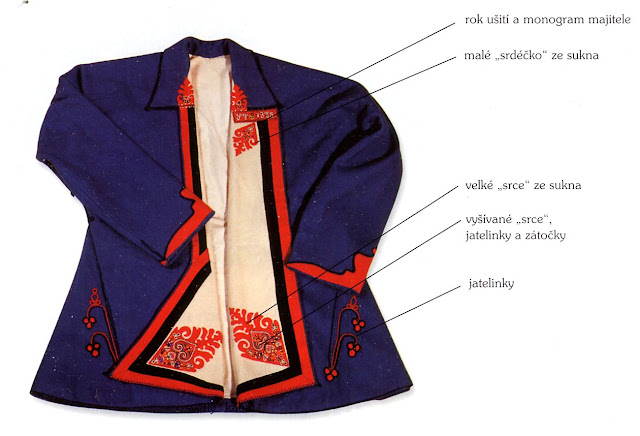Hello all,
Today I wish to continue my last posting with a description of the mens' costume of Horňácko.
There is a white linen shirt with narrow band of embroidery around the neck and on one side of the overlapping front opening. It is held closed with 4 narrow white ribbons. Like the womens' costume, the color of the embroidery varies with the occasion.
For boys and for work, simple linen trousers are worn, such as can be found throughout the Carpathian basin.
An apron with red woven and/or embroidered ornament is part of this outfit. This is a characteristic shared with Slovak and Hungarian mens' costumes. Here is a folklore group from this area posing with some Estonian women.
For festive and ceremonial dress, tighter-fitting blue pants are worn, which are embroidered on the front and around the pocket flap. The narrow belt which goes around the waist twice is also found in Slovakia.
When dressing up, younger boys wear an embroidered kerchief tied around their waists. When they get bigger and start wearing the blue pants, the kerchief is folded and placed behind the front flap of the pants.
The kerchief is embroidered in red cross-stitch, typically including four corner designs, four birds, a wreath a border around the outside and the lyrics to a song.
This is worn by single men. You will rarely see married or older men wearing it. Here is a baptismal photo showing the parents and godparents.
There are two types of vests worn by men. Younger men wear a vest with concave front edges in black or blue wool or damask with embroidered front edges and elaborately embroidered backs.
Older men wear a white wool vest with straight fronts which is also highly embroidered. Sometimes younger married will wear this as well, especially for important occasions. If you look closely, both the groom and the older gentleman are wearing this vest.
An open fronted jacket of either blue or white wool called Kabat is worn on festive occasions.
The outfit is completed by high boots and a hat with rows of ribbon and multicolored cord. This normally has white rooster tail feathers tucked into it.
At his wedding the groom wears a special ornament attached to his hat. He also wears a woman's head cloth, the longer type worn 'with corners down' around his waist with the embroidered ends hanging in back over his jacket.
Sheepskin caps are worn in cold weather, as in most of Eastern Europe.
Various types of overcoats are worn at need. One of them resembles the Lemko Chuhania or Hungarian Szur. In this region it is called Halena. Unusually, sometimes the arms are inserted into the sleeves.
Thank you for reading, I hope you have found this interesting.
I will close with just a few more images.
A couple dance from this region. This seems to be midway between Goral dance and Csardas.
https://www.youtube.com/watch?v=Oi-R--oSS8c&NR=1&feature=endscreen
Another couple dance by the same group. In this one the girls are all wearing the everyday version of the back apron. They are also wearing knee socks and kiepce [moccasins], instead of boots.
https://www.youtube.com/watch?v=CiX_6Ucs5ys
Feel
free to contact me with requests for research. I hope to eventually
cover all of Europe and the Former Russian Empire/Soviet Union. I also
gratefully accept tips on source materials which i may not have. I also
accept commissions to research/design, sew, and/or embroider costumes or
other items for groups or individuals. I also choreograph and teach
folk dance.
Roman K.
Source Material:
Věra Častová et al, 'Kroje Horňácké Obce Velká nad Veličkou', Velká nad Veličkou, 2000
Alena Vondruškova -Vlastimil Vondruška, 'Schatzkammer der Volkskultur', Praha [Prague], 1987
Jitka Staňková - Ludvík Baran, 'Slovenské a České Tradične Kroje', Praha [Prague], 2004
Jiřina Langhammerová, 'České Lidové Kroje', Praha, 1994
Jiřina Langhammerová, 'Lidové Kroje z České Republiky', Vlkova, 2001
Helen Cincebeaux, 'Treasures of Slovakia', Nitra, 1996
Jitka Staňková - Ludvík Baran, 'Lidové Kroje Slovácka', Praha [Prague],
Antonin Vaclavik - Jaroslav Orel', 'Textile Folk Art', London, 1956
Karel Šmirous - Blažena Šotková, 'Volkstrachten in der Tschechoslovakei', Praha, 1956




































Do you have any info or photos of 19th Century Polish mountaineers in everyday working clothes? These photos (http://pl.wikipedia.org/wiki/Plik:Klimek_Bachleda_ze_%C5%9Bwistakiem.jpg)(http://en.wikipedia.org/wiki/File:Klimek3.jpg) are of a mountaineering guide named Klemens Bachleda (1849-1910), note the relatively plain trousers and vest, slouch hat and lace-up high-top shoes.
ReplyDeleteRegards,
Frank Brayman
You can reach me at "Archer6228(at)hotmail(dot)com"
very informative. I am looking for embroidery patterns for Rusyn's in Hrabovcik
ReplyDeleteHi,
ReplyDeleteYour site is fabulous. I am of Rusyn extraction and I have read from your Blog that you don't have a lot of information on the costumes of the Transcarpathian area of Ukraine. You might try contacting the Byzantine Rite Catholic Diocese of Parma, Ohio, They have a cultural center and museum which might have information of benefit to you. One of my grandfathers was from Hudlovo and a grandmother was from Horlyo--both apparently suburbs of Uzhorod. I'm still researching the other set of grandparents (lol). Thank you for sharing your marvelous store of knowledge!
I attempt to trace the migration of people and hence the origin of this desirable clothing style here: https://www.facebook.com/notes/nick-ashton/the-baltics/10153606470034030
ReplyDelete